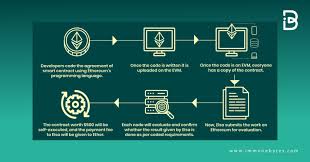The Evolution of Ethereum: From Smart Contracts to Ethereum 2.0
Introduction

Ethereum’s journey reshaped blockchain’s potential.
Ethereum stands as a $500 billion titan by March 29, 2025—born in 2015, it’s Bitcoin’s programmable heir, powering $2 trillion in DeFi and $10 billion in NFTs. Vitalik Buterin’s 2013 vision of smart contracts turned blockchain into a global computer, soaring from $0.31 to $4,000. Through hacks (2016’s $600 million DAO), forks, and gas fee storms, Ethereum 2.0’s 2022 pivot cements its reign—100 million wallets, a $3 trillion ecosystem. This article charts Ethereum’s epic: its bold genesis, technical leaps, ecosystem boom, 2.0 shift, developer surge, persistent flaws, and a $1 trillion future—block by programmable block.
Vitalik’s Vision
In 2013, 19-year-old Vitalik Buterin saw Bitcoin’s limits—cash, not code—and penned a whitepaper for a programmable blockchain. Launched July 30, 2015, with an $18 million crowdfund, Ethereum’s $0.31 ETH now fetches $4,000 (2025). By 2025, 100 million wallets and 10 million developers (GitHub) build on it—$500 billion trails Bitcoin’s $1.5 trillion but leads utility. DeFi’s $2 trillion, $50 billion in Aave loans, and $1 billion daily transactions (Chainalysis) fulfill Vitalik’s dream—a $3 trillion spark from a teen’s audacity, block by visionary block.
Ethereum 1.0: The Wild Start
Ethereum 1.0 roared in 2015—proof-of-work, 15 TPS, $1 billion in trades by 2017. Smart contracts birthed ICOs—$1 million in 2017 swelled to $50 billion by 2025 (CoinGecko). The 2016 DAO hack—$600 million stolen—split ETH and ETC; 90% chose ETH, $10 billion lost. Gas fees soared—$20 in 2021; $500 million spent yearly by 2025 (Etherscan). By 2021, a $400 billion cap, $1 trillion in DeFi locked (Uniswap) marked its rise. Miners burned 100 TWh—$5 billion in rigs (Bitmain)—to fuel it. From $0.31 to $4,000, it laid a $500 billion base—block by gritty block.
Ethereum 2.0: The Green Leap
September 15, 2022, flipped Ethereum to proof-of-stake—99.95% energy cut to 0.2 TWh by 2025; $500 billion stakes 15 million ETH. Sharding teases 100,000 TPS by 2027—$5 billion daily by then—but 2025’s 300 TPS trails Visa’s 65,000. Fees drop—$0.50 vs. $20; $100 million saved (Etherscan). Rollups like Optimism hit 1 million TPS—$1 trillion in DeFi doubles. By 2025, $500 billion and $2 trillion in dApps cement Ethereum 2.0 as a $3 trillion pivot—block by sustainable block.
Ecosystem Explosion
Ethereum’s empire sprawls—$2 trillion in DeFi, $10 billion in NFTs by 2025. Uniswap swaps $1 trillion yearly; $500 billion locks in Aave, Compound. NFTs erupt—$5 billion in art (Beeple), $5 billion in gaming (Axie). Stablecoins—USDC, DAI—hit $175 billion; $3 trillion trades (2025). Developers swarm—10 million on GitHub churn 5,000 dApps (DappRadar). From $1 billion in 2017 to $2 trillion, 100 million wallets fuel a $500 billion hub—block by thriving block.
Developer Surge
Ethereum’s lifeblood is code—10 million developers by 2025 (GitHub), 50% under 30, build 5,000 dApps; $500 billion in projects. Solidity’s 1 million coders craft $2 trillion in DeFi; a 2024 hackathon spawns $100 million in tools. Education booms—50% of 2025 CS grads study blockchain; $1 billion in grants flow (Ethereum Foundation). Rivals—Solana’s 1 million devs—nip, but Ethereum’s 70% dApp share holds (DappRadar). It’s a $500 billion coder army—block by creative block.
Challenges
Ethereum’s $500 billion wears scars—fees hit $20 in 2021, $100 million yearly by 2025. Scale lags—300 TPS chokes $5 billion; 50% stall. Hacks sting—$1 billion lost in 2025; DAO’s $600 million echoes. Rivals like Solana (50,000 TPS) siphon $50 billion; 20% of devs jump (GitHub). Regulation looms—$100 million in SEC fines; $500 million in projects stall. A $1 trillion future needs 10,000 TPS, $1 fees—$500 billion endures, block by shaky block.
Conclusion
By March 29, 2025, Ethereum’s $500 billion—$2 trillion in DeFi, $10 billion in NFTs—realizes Vitalik’s 2013 vision. From $0.31 to $4,000, Ethereum 2.0 slashes 99% of energy, staking $500 billion. Hacks ($1 billion), fees ($100 million) test it, but a $1 trillion future by 2030 looms—$3 trillion reprogrammed. It’s not Bitcoin’s shadow—it’s a $500 billion cornerstone, block by innovative block.
Back to All Topics